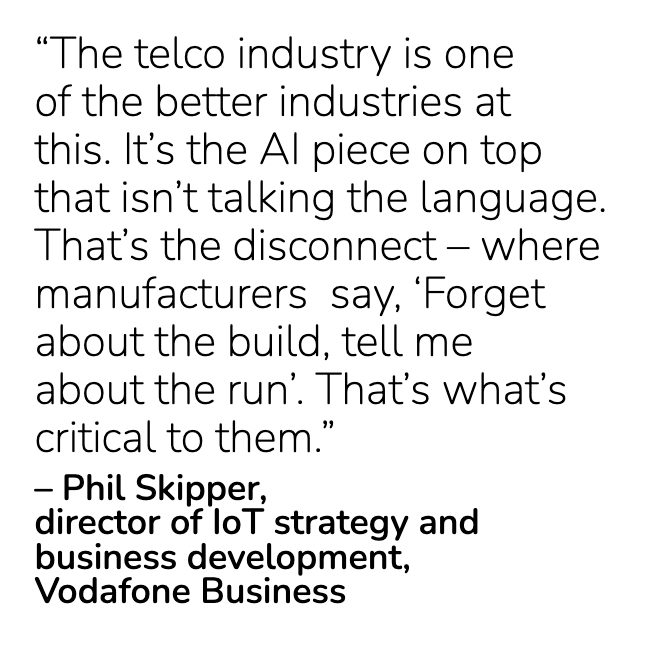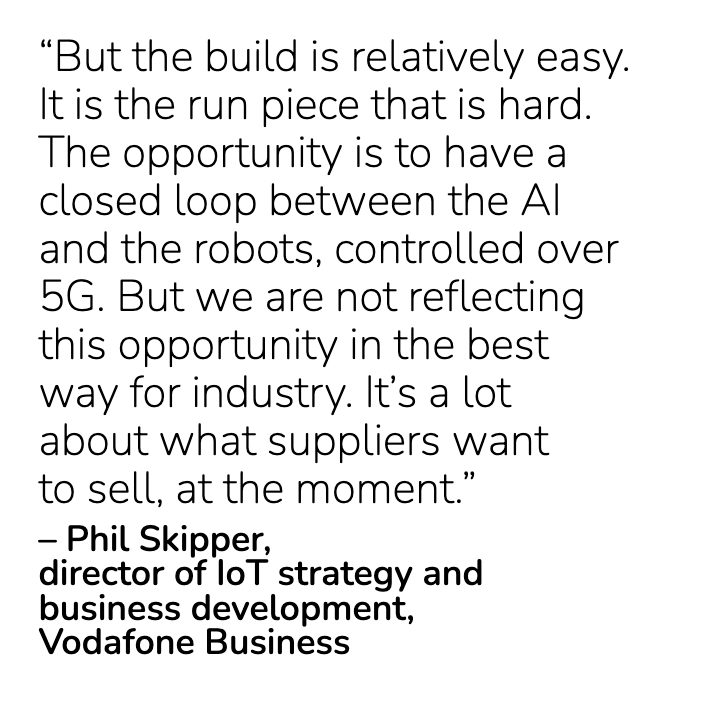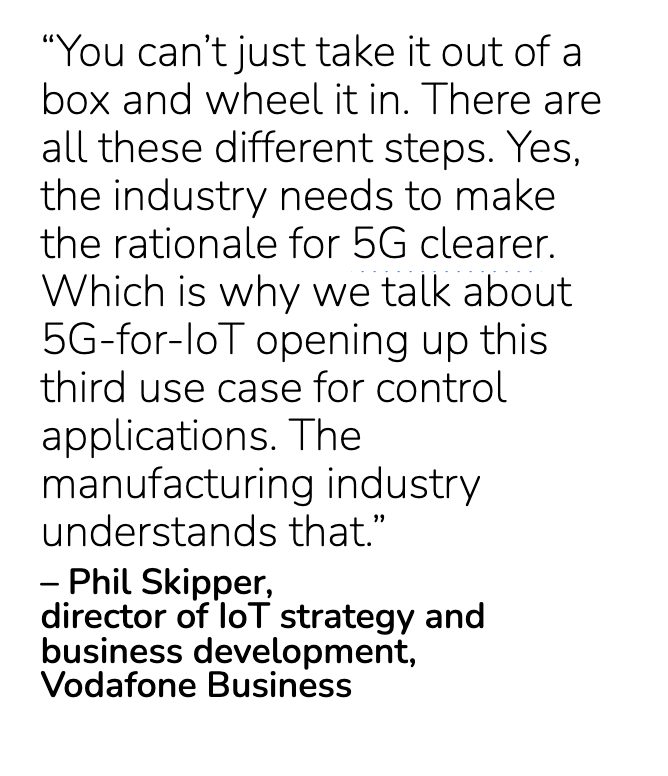Note, for more on this topic, and to hear more from Vodafone and others, join the Enterprise IoT Insights webinar on Industrial 5G (From Setting Standard to Becoming Standard) on April 28 – also featuring speakers from ABI Research, MFA (MulteFire Alliance)/Nokia, and Schneider Electric; check back here, also, for the editorial report on the same topic.
A couple of weeks back at MWC, Enterprise IoT Insights caught up with Phil Skipper, director of IoT strategy and business development at Vodafone Business, to discuss the developing story around industrial 5G, which took centre stage at the Barcelona showcase. The conversation, printed in full below, considers a number of challenges for the wider supplier ecosystem to get to grips with the Industry 4.0 opportunity.
Skipper suggests the market is struggling to dovetail in ‘co-creation’ – to bring together the component parts, in the form of analytics and big data (AI), devices and robotics (IoT), and edge infrastructure (networking and compute) – in order to rig-up a coherent digital-change platform for industry. Mobile operators, he implies, get wrongfully blamed for this disconnect; they are holding up their ends of the bargain on private 5G, he reckons.
If any side is struggling with the translation, to go from tech solution to business problem (and back again), and to join with its coefficients in the new tech equation, then it is the AI brigade, he suggests – which is faltering with the “language” and failing to bring meaning. His explanation is better, and written below; the bigger point is that the tech side is struggling, all together, to show itself in the best light, but that it is also just the natural course for new tech.
Generally, each party is too-fixed on selling, he says – and, by extension, on building edge-based solutions, typically covering private 5G as an early discipline. There are too many cooks, too few chefs, and relatively little in the way of front-of-house management, he suggests; the Industry 4.0 stew is being cooked in shifts, effectively, and left to go cold on the counter. Which is why so much gets stuck in pilot mode.

He reverts back to the old plan-build-run model for big infrastructure projects. Proof is in the eating, as it goes; everyone is scrambling for a place in the kitchen, when the customer is engaged on the other side, in the dining area, making the order and also consuming it. Skipper, putting the case for Vodafone, but also speaking effectively for the telco community, maintains the ‘run’ phase is where Industry 4.0 will be lost and won.
But Industry 4.0 will not be rushed; this challenge with edge-system design and management is more crucial for critical industry just because it is more complex, he implies – and also more paranoid and conservative. Plus, it turns on longer upgrade cycles than anywhere else. Vodafone has reorganised itself horizontally and vertically, says Skipper, to offer a take-away matrix of tech can-do and trade know-how.
There is much more, printed below. To finish here, before handing over; Skipper draws an interesting comparison with the cellular IoT market – plain enough, but never said – that private 5G is on the same path, caught momentarily between network-building and device-making. Vodafone, perhaps more than any other operator, has pushed the NB-IoT story, and has in recent months seen the ecosystem fall into line and deals fall into place.
Frustratingly, Skipper remains unable to put on record which firm signed that mega deal on NB-IoT devices (client confidentiality, and all that), trailed at the end of last year, except to say the ink is dry on the deal and the (meter) devices are going into service. But the parallel is interesting because it says the private 5G market is still developing (of course), and that telcos – which have seen disruptors come and go, and co-exist, in the low-power end of the IoT market – are good at the longer game.
A bunch of other conversations from MWC (and everywhere), which will be put live in the next weeks (as possible), will say otherwise, of course – that the race is on, already, and will not wait for the old telco market to limber up. And the conclusion, as best it can be written in 2022, will probably say, rather cowardly but quite correctly, that the market will be carved up all ways – by technology types, supplier types, and industry types.
But here’s Skipper, finally, always good to listen to; all the answers below are from him.
Look out for the new editorial report and webinar session on industrial 5G (from setting standard to becoming standard) on April 28, featuring Phil Skipper from Vodafone, plus Asimakis Kokkos, Chair of the Technical Specification Group at MFA (MUlteFire Alliance) and Head of Technology Ecosystems at Nokia, and Leo Gergs, Senior Analyst at ABI Research, among others. Sign up here for the session and report.
…
What do you make of the MWC fanfare around private networks and industrial IoT this year? It feels like the real 5G story has landed, at last – that enterprises matter more than consumers.
“Industrial 5G is one of the big topics – which is not about how 5G changes things for consumers, with gaming and faster-everything, but about what 5G does that is different. Which means 5G for IoT, in other words, and this third use case around control. People haven’t got that yet. They talk about robotics and AI; what they miss is the link between. You might be clever enough to get the insights, but are you clever enough to make the robot smart [and close the loop].
“It’s getting there, but it is still very siloed – as AI, robotics, and private networks. There are very few who see how it all fits together. Because if you’ve got AI and you’ve got robots, and you’ve got the network between, then you have a control system for advanced manufacturing. Which is very different to what a lot of people are talking about, which is really just factory automation. That’s the thing for us.”
 Just explain advanced manufacturing versus factory automation.
Just explain advanced manufacturing versus factory automation.
“Factory automation is where you get a robot to put part A into part B into part C, and screw them together as a finished unit. Advanced manufacturing is where you are able to inspect the components as they go in, and detect and swap faulty sub-components – and, most importantly, measure quality as you go along. So you don’t put it all together only to have to scrap it at the end. You adjust the process with tools that take things off and swap things in.
“Robots just do the same thing over and again – to the point part A doesn’t even fit into part B because it’s the wrong shape. AI allows robots to be adaptive. We see it in warehousing, say, already where you can skew things about all over the place, and [robots / AGVs] change their route based on what is coming down the line. That ability to flex and adapt is the really interesting area in manufacturing.”
Talk briefly about this new Digital Asset Broker announcement. (See article: Vodafone intros blockchain-based trading platform for IoT devices.)
“It is this idea about the economy of things, made up of billions of micro transactions. Which doesn’t mean cash transactions necessarily, but transactions just to authorise one machine to talk to another. It’s the layer up from connecting to actually transacting. A good example is a car going into a congestion-charge zone, and authenticating itself with the charging infrastructure – the traffic lights and tolling systems.
“The idea is that every device becomes an autonomous device for transacting with other devices. And within that, there is a SIM solution and a blockchain, and various partners hanging off the blockchain. It is a fiscal system, which works to fiscal rules around financial payments. So MasterCard is involved. And we have a setup in [Vodafone’s hometown of] Newbury, where drivers don’t want to think about the charge scheme they’ve signed for, but just about charging their car in a very simple way.”
Any word on that big NB-IoT deal – which the whole cellular IoT market, I would suggest, is holding out for? (See article: Did IoT just get ‘massive’? Vodafone signs multi-million multi-market NB-IoT deal.)
“Nothing that we can say, I’m afraid – except to say that it is working, and being rolled out.”
Let’s go back to this industrial 5G story; the OT crowd is stalking the halls at MWC, saving up for Hannover Messe, suggesting that 5G is not a 2022 story at all, so far as industry is concerned – that it is not even a 2023 story, actually, but a 2024/5 one. And despite the talk at the show, a lot of new Industry 4.0 work is on LTE, as yet. Of course, mobile broadband is relevant for industry too, and there is a 3GPP release schedule for a number of new industrial 5G capabilities. But how do we go to this next stage – to make 5G mainstream for factories, and to make this third use case about factory control a reality?
“There are two bits to this, and, actually, it is very much like with NB-IoT. The first thing is you need the network; the second thing you need is devices. If I’m going to produce 5G devices, I want to know that there are many networks in many countries so I can sell as much as possible. But if there’s a lack of 5G devices to attach to your private 5G network, then why build a 5G network in the first place? That is the challenge, to an extent.
“And we always said with NB-IoT that it will wait until OEM products come off the drawing board. Some industries are already well advanced with 5G. Automotive, for example, has been designing 5G into cars for years – just because the development cycle is so long. With manufacturing, 5G is starting to go into all sorts of mobile machines, as work-in-progress becomes work-in-motion – with AGVs and robots and transfer tables. But there’s a lag.
“Basically, 5G networks are now going into industrial sites to support three core applications: virtual reality, because the equipment is basically there already, so it becomes more like an application than a use case; data for digital twining and digital threading, which is again somewhat separate of end user devices; and work-in-motion, which is where you see some of the more advanced materials handling devices coming out with 5G.
“[In terms of 5G industrial devices], the first will be manufacturing assets that by definition can’t be tethered – which means AGVs and forklifts carrying work from one place to another, and transfer tables and materials handling. It is the same in hospitals, say, with portable diagnostics kits. That’s where it’s going to happen first. Because you simply can’t afford to have wires.
“You see these machines in factories and hospitals with big umbilicals behind them, and [5G affords a way to] get rid of all of that…But it comes down to that timeline to sync the availability of networkS with the availability of devices. But there is a big accelerator coming, as well. Because once you’ve developed process Number One, and deployed private 5G to support it, then the infrastructure is in place to drop-in other use cases on top. So you can now do Process Two and Process Three.”
Will the industrial market settle, actually, around those kinds of use cases? Will the supposed glory days of Release 17 be quite fleeting or niche, actually? Release 17 is presented in some quarters as if it will be a watershed moment for Industry 4.0, to drive advanced manufacturing. Is that wrong – that what will happen is those capabilities will help here and here, but they won’t drive massive industrial usage?
“Manufacturing is a risk avoidance business. You have a production schedule, and you make sure you hit that schedule. Technology is used in manufacturing to improve process output and process quality. That’s what it’s all about. What you will find is that 5G will go into very specific places – into those devices that cannot be tethered, including people. So 5G will feature heavily in those AR/VR and lone worker applications, for example.
“When it comes to big pieces of capital-plant, they are typically made in one location, shipped to a factory, and then integrated into the factory. So a plastic moulding injection machine, for example, is probably going to be wired. It might be connected into a [production] cell using 5G, but a lot of the IoT sensing will be wired. Because of cost, because you might as well run it in [fixed] comms, and also because of support, because factory machines are typically managed by electromechanical engineers, and not network engineers.
“If you look at the three layer hierarchy in a factory, you’ve got machines, work cells, and SCADA systems. The machines will remain as they are, [connected by cable]; the cells may well be connected by 5G; and the SCADA system will likely be a combination of the two. Because the SCADA links horizontally to vertical manufacturing stacks. 5G will really reside in that bit in the middle – between the machine and the factory automation.”
So is the idea of fold-up/fold-down factory production, where production machines and work cells can move around to accommodate new tasks, a myth? Is it just for ’greenfield’ factories? Is it not viable for the day-to-day industrial market?
“That seldom happens because it’s so disruptive. But you are also right that you can re-site machines from location A to location B with a 5G connection. They may be linked by untethered [5G] devices, which is how the work gets moved. But it’s going to be a real combination. The idea that everything goes on 5G, from the smallest IoT sensor, is harder because they need to be maintained as an operational asset, by teams that are close to them.
“In the end, cell control is certainly going to be a big play for mobile private networks. The other one will be untethered devices within the factory, and the third will be everything around AR/VR, digital twins, and co-robotics – where it’s all about orchestration and coordination of work-in-motion.”
Verizon talked on stage at MWC about a poll it had commissioned that found that industry loves Industry 4.0, but isn’t doing much about it; the message was there is this disconnect between strategy and action. Do you think that is a problem? Or is it rather like with IoT – where the question is always why three quarters of IoT cases fail, and the response should perhaps be that it is like asking why a toddler can’t ride a bike? I am writing a piece about how industrial 5G goes from setting standard to being standard, for enterprise users, and I wonder if the premise is a little skewed – that the answer is, just, that this stuff takes time, and ’what did you expect’? And is that even a fair defence?
“It’s this thing, that just because you can, doesn’t mean that you will. There are significant benefits for factories from 5G, but factories evolve incrementally. The worst thing to do is to change everything at once. Instead, you have to create a process, optimise the process, optimise the next process, and then optimise how they work together. The telco industry is probably one of the better industries at understanding this. It’s the sort of AI-type data processing pieces on top that aren’t talking the manufacturing language. I think that’s the disconnect – where manufacturers are saying, ‘Forget about the build, tell me about the run’. Because that’s what’s critical to them.”
Do you mean, ’tell me about data management, and what to do with the data’?
“No, no. Just: ’Tell me how you are going to support me during the run’.”
But that’s a telco question, not an AI question, surely?
“It is a supplier-ecosystem question. Everyone is saying, ’I can build you this’. The response is, “Look, if you are building it, there’s no risk to me – but when it appears in my factory, the risk is all mine’. Manufacturers want to know how to manage risk, which is why we talk about IoT as an operational asset. Everyone we talk to says, ’Yeah, that’s fine; I believe you on the tech story – now tell me the story about how flexible manufacturing works long term?’
 “That’s the narrative many of these [non-telco supplier] industries are failing to land. Whereas what we are saying, on private networks, is, “Look, we will build you a mobile private network, with these particular features, which is going to be the most reliable way to access productivity’. And the manufacturer goes, ‘Oh, that’s good – so the kit is over there, and I’ve got a support agreement that says you will turn up if it goes wrong’.
“That’s the narrative many of these [non-telco supplier] industries are failing to land. Whereas what we are saying, on private networks, is, “Look, we will build you a mobile private network, with these particular features, which is going to be the most reliable way to access productivity’. And the manufacturer goes, ‘Oh, that’s good – so the kit is over there, and I’ve got a support agreement that says you will turn up if it goes wrong’.
“They get that; it fits with their thinking about how to maintain it. But then you get into all of these applications on top – and how you bolt in all of this autonomous kit. And it’s all about reliability, meantime between failure, all of those questions – so the owner has a view of how it fits with their manufacturing schedule. If you talk to the mining industry, say, it doesn’t care about the individual machines; it only cares how Machine 1 links to Machine 2, and then to machines 3 and 4, and finally to a conveyor which dumps all this stuff out of the mine.
“It wants to know what the process looks like when it is connected – so that 500 tonnes of stone comes out the other end on time. That is where the problem is. All these things have to work together. At the moment, like we said at the start, there is one [sales] conversation about analytics and another about robotics [and another about private networks]. But the build is the easy bit, relatively speaking; it’s the run piece that is hard. The opportunity is to have a closed loop between the AI and the robots, controlled over 5G. But we are not reflecting this opportunity in the best way for industry. It’s a lot about what suppliers want to sell, at the moment.”
And who’s responsible for that? Are you saying Vodafone can take care of all of that, including the whole Industry 4.0 system optimisation, or are you saying Vodafone will only do the network run?
“Yes, we will do the network. And if you want some AR/VR, come talk to us. Because that’s pretty core to what we do. And if you want lone-worker [solutions], then we can do all of that as well. But ‘manufacturing’ is too-loose a term. People talk about ‘delivering big data for manufacturing’. But it doesn’t go into sufficient segmentation; you’ve got to distinguish between continuous manufacturing and discrete manufacturing, precision engineering and non-precision engineering, oil and gas…”
But from a Vodafone point of view, are you able to go in and run the consultancy and management, and then bring the ecosystem together?
“Yes. We’ve restructured for that, so we have these horizontal layers where IoT is part of the connectivity business and private networks are part of the cloud-and-edge compute business, and then we have these seven [vertical] centres of competence on top. So if a mining customer wants to talk about an application for mining, they can talk to somebody that knows mining. They may not know telco, but they certainly know the mining game.
“And then if they want to talk about deploying infrastructure, then they can talk to the group that does private networks and edge computing – to people who know about edge infrastructure. It is different because lots of suppliers are [selling] some sort of vertical stack, as a solution for ’manufacturing’, say. Whereas enterprises want to buy a bit of comms, a bit of infrastructure, a bit of application – and they are different conversations with customers.
“The person in charge of factory infrastructure wants to know the ins-and-out of private networks, and how all the kit is integrated and supported. If you talk to the guy producing cans of beans, he’s got a very different view of life. One single sales message does not work. It comes back to the old adage: know your customer. And manufacturing is not just one customer; it relies on multiple customers with multiple responsibilities in order to make that output happen.”
Is there any risk of over complicating this segmentation thing? There is an argument that the telecoms industry is guilty of not simplifying enough – to the extent that app stores and app developers have got away from it, messaging has got away from it, and unified comms has got away from it. The hyperscalers, among others, are coming into this market, promising to deliver 5G to enterprises as an easy Wi-Fi kind of experience. Clearly, industrial 5G for manufacturing is not the same as broadband 5G for schools, but is there a worry that this is all too complicated for factories, as well?
“It depends who you talk to. For the person who runs the mobile private network, it is a complicated conversation. It’s the difference between the sell and the run. If you can make the value proposition clear to everybody, then you are in the conversation. But then the conversation goes from simple ‘why’ to the difficult ‘how’ – and those things don’t necessarily line up. Factories are complicated, and your 5G solution has to integrate with all of this and do all of that.
 “So you can’t just take it out of a box and wheel it in. There are all these different steps. Yes, the industry needs to make the rationale for 5G clearer. Which is why we talk about 5G-for-IoT opening up this third use case for control applications – where high bandwidth, low latency, and quality of service gives you consistency, and consistency gives you control. And the manufacturing industry understands that.”
“So you can’t just take it out of a box and wheel it in. There are all these different steps. Yes, the industry needs to make the rationale for 5G clearer. Which is why we talk about 5G-for-IoT opening up this third use case for control applications – where high bandwidth, low latency, and quality of service gives you consistency, and consistency gives you control. And the manufacturing industry understands that.”
But is there a worry these hyperscalers will just modularise everything like a take-away menu? ’You want a network? Here’s a network’. ’You want a predictive maintenance app? Here’s one of those’. ’You want VR? Here you go?’ Where everything is just an app or a plugin on an edge server? All the complexity is abstracted, and a network is just a network – not an ’industrial 5G control network’?
“But that’s plugging-in from a hyperscaler perspective [not from a customer perspective]. The customer is going to say, ‘Yeah, but hang on, I’ve got a fixed line here, and all of this legacy stuff – and I don’t want do this bit yet.’ That is where things become difficult. Here’s the waterline, and you can talk about a simple networking sale on top, but there’s a whole load of complexity around the legacy underneath. That’s where a lot of the value gets created.
“Some of this stuff might be 30, 40, 50 years old. And the factory is producing stuff, so you can’t just shut the whole factory down for six months to build something brand new. But we’re seeing asymptotic changes in certain industry segments. Electric vehicles, say, need brand new production lines and brand new production processes, and it’s probably the biggest change that’s hit automotive in the last 100 years.
“So it’s something of a greenfield market. There are other segments, too – like silicon manufacturing, because of the global chip shortage. It means new silicon factories are being opened, which means you might as well start from scratch. By contrast, a lot of brownfield manufacturing just needs to modernise rather than to change. It’s like with smart cities. You look at a smart city that’s built from the ground up, and it’s all ’smart’.
“But you turn around and most cities are over 2,000 years old – so it’s almost like empathy that needs to go into this. It is not just about what you want to sell, but about what customers want to buy. And in manufacturing, particularly, it’s as much about the run as it is about the build. Can you build it so somebody can run it? That’s the trick to this whole thing. And that’s why we have a sales team that talks about the ’why’, and a pre-sales and technical architecture team that talks about the ’how’. And they are quite different competency sets.”
Note, for more on this topic, and to hear more from Vodafone and others, join the Enterprise IoT Insights webinar on Industrial 5G (From Setting Standard to Becoming Standard) on April 28 – also featuring speakers from ABI Research, MFA (MulteFire Alliance)/Nokia, and Schneider Electric; check back here, also, for the editorial report on the same topic.

